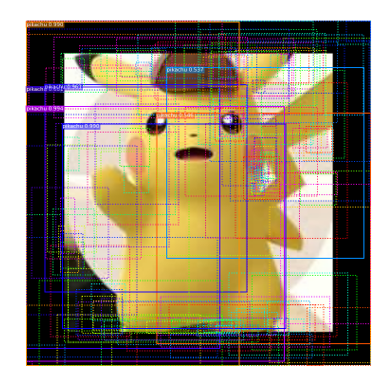Pokémon Object Detection with Mask R-CNN
Project Overview
This personal project, developed during my time at the Université Paris-Est Créteil, explores the application of Mask R-CNN for custom object detection. I implemented transfer learning techniques with a pre-trained Mask R-CNN model (originally trained on the COCO dataset) to detect and segment custom objects - specifically Pikachu from Pokémon - in images. This work demonstrates how deep learning can be adapted to specialized detection tasks without requiring extensive training data.
Implementation Details
I utilized a pre-trained Mask R-CNN architecture as the foundation and fine-tuned it to recognize Pikachu from various angles and contexts. The project involved:
- Adapting the Mask R-CNN architecture originally pre-trained on COCO dataset
- Creating a custom dataset with labeled Pikachu images
- Implementing transfer learning to recognize this character not present in the original dataset
- Optimizing detection parameters for higher accuracy
[Mask R-CNN detection result showing bounding boxes and segmentation]


Parameter Optimization
A significant part of this project involved experimenting with various parameters to improve detection performance:
1. IoU Thresholds for Region Proposal Network (RPN)
- Adjusted upper threshold (positive samples) and lower threshold (negative samples)
- Found optimal performance with lower bound at 0.3 and upper bound at 0.7
- Values between thresholds were ignored during training to improve robustness
2. ROI Box Head Architecture
- Experimented with varying numbers of convolution filters (optimal: 4 filters)
- Tested different configurations of fully connected layers (settled on 2 FC layers)
- Balanced complexity against potential overfitting
3. Non-Maximum Suppression (NMS) Optimization
- Fine-tuned pre-NMS and post-NMS proposal numbers
- Default values: 4000 pre-NMS proposals, 1000 post-NMS proposals during training
- NMS suppresses overlapping bounding boxes to retain only the highest confidence detections
Technical Challenges
The project presented several interesting challenges:
- Annotation Efficiency: Creating efficient workflows for annotating custom objects
- Transfer Learning Optimization: Finding the right balance between frozen and trainable layers
- Hyperparameter Tuning: Systematic experimentation with detection parameters
- Small Dataset Handling: Implementing data augmentation to maximize learning from limited examples
Results and Insights
The fine-tuned model successfully detected Pikachu in various contexts with high precision. Key findings include:
- Transfer learning significantly reduced the amount of training data needed
- Parameter tuning had substantial impact on detection quality
- NMS threshold values greatly influenced the final detection results
- The model generalized well to different poses and backgrounds of the character
Technologies Used
- Python for implementation
- TensorFlow and Keras for deep learning framework
- Mask R-CNN architecture for instance segmentation
- OpenCV for image processing and visualization
- Data augmentation techniques for training set expansion
Future Directions
- Expand detection to multiple Pokémon characters
- Implement real-time detection capabilities
- Explore instance segmentation for more detailed character analysis
- Compare performance against newer architectures like YOLO and EfficientDet